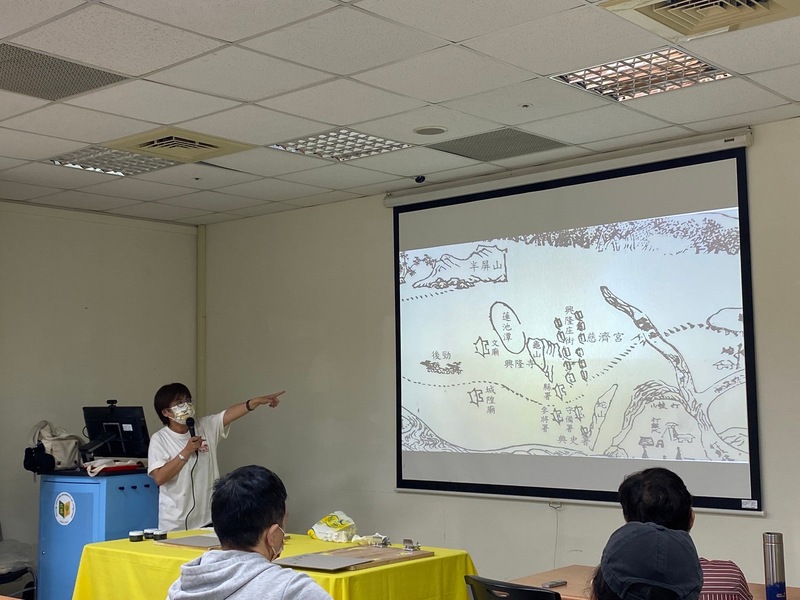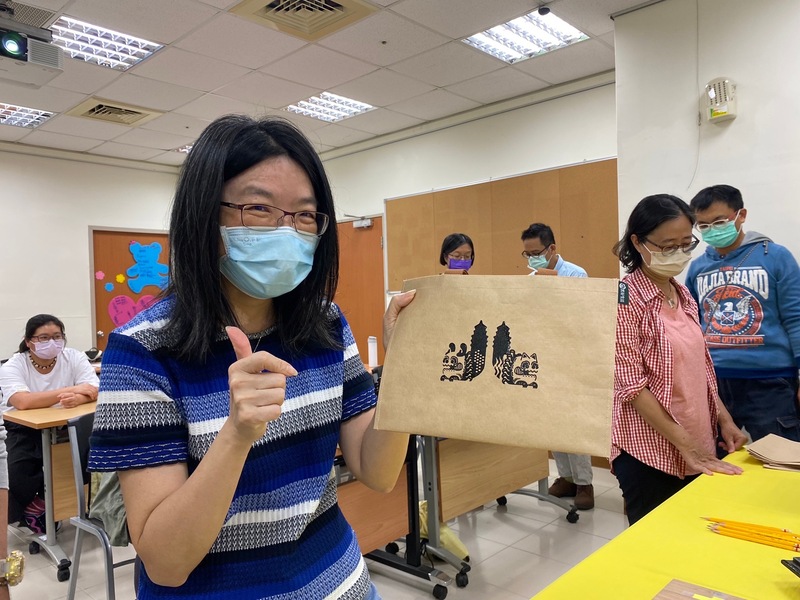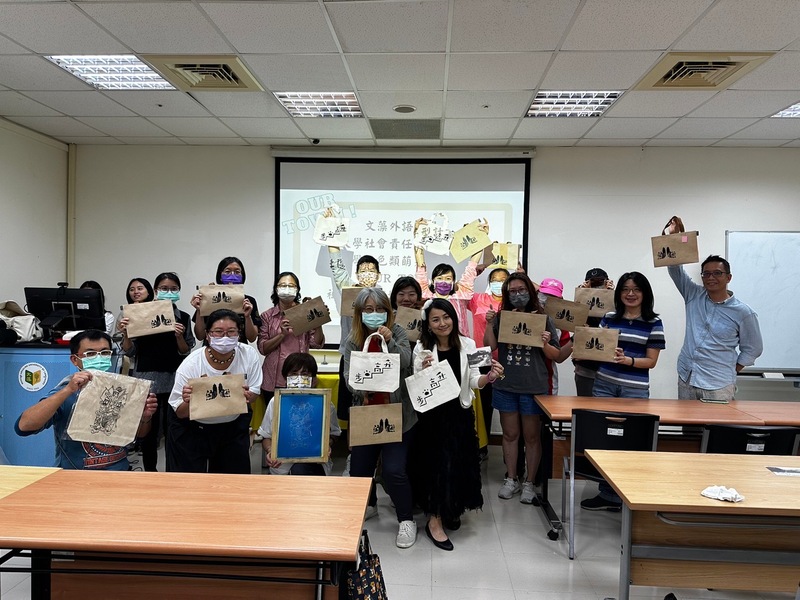【計畫團隊學生|林亭妤報導】
文藻外語大學社會責任實踐計畫─「OUR TOWN 社區永續跨域共創平台計畫」,於本學期開設多類共創社群,其中「文化體驗設計社群」團隊,有幸與舊城文化協會合作,邀請邀請張碧玉老師蒞臨文藻教學絹印製作與講述文史相關知識,讓學員能於短短時間內,在體驗中獲取愉悅與成就;在聆聽故事中吸收豐沛的在地人文與歷史養份。
Wenzao Ursuline University of Languages' University Social Responsibility Practice Program, "OUR TOWN Community Sustainable Cross-Domain Collaborative Platform Project" has opened various co-creation communities this semester. Among them, the "Cultural Experience Design Community" team is fortunate to collaborate with the Kaohsiung Cultural Association, inviting teacher Zhang Biyu to Wenzao to demonstrate the production of silk printing and share related cultural and historical knowledge, allowing students to gain pleasure and a sense of accomplishment in a short period of time through hands-on experiences. The goal is for students to absorb abundant local culture and historical nutrients through listening to stories.
文化體驗相關活動已來到第三場,本次體驗項目為「潮城袋絹印」,有別於以往,這次先行讓參與學員進行體驗,再聆聽文史故事—龍虎塔。在體驗部分,碧玉老師先與學員們分享絹印由來、製作方式,以及所需材料等等,並以生動有趣的影片燃起學員們的好奇!此外,碧玉老師表示:「絹印」是一種有非常有手感和溫度的印刷,因為它是一種特別的印製方式。簡單來說,即是在絲綢材質的框架上,透過感光板將印紋以外的網目封閉,再以刮刀將油墨慢慢通過網目,接著圖樣會慢慢呈現出來。這項工藝的應用廣泛,不只能印在布料上,也能夠在看板、茶具甚至電器用品上做圖案印製。發展之今,也與近代畫版技術結合,變得更加豐富與多元化。
The cultural experience-related activities have now reached the third session. The current experience project is "Old City Tide Bags and Silk Printing." Unlike previous sessions, this time, participating students were first allowed to experience silk printing before listening to the cultural and historical story of the Dragon and Tiger Pagoda. In the experiential part, teacher Biyu first shared the origin, production method, and required materials of silk printing with the students. Through lively and interesting videos, she sparked the curiosity of the students. Teacher Biyu also explained that "silk screen printing is a kind of printing that has a very hand-made and warm feeling.” Simply put, it involves using a photosensitive plate to block the mesh outside the print on a silk frame. Then, ink is slowly scraped through the mesh with a scraper, and the pattern gradually appears. This craft has a wide range of applications, not only on fabrics but also on signs, tea sets, and even electrical appliances. Today, it is combined with modern plate-making technology, making it richer and more diversified.
龍虎塔的來源可追溯自日治時期,當時日本人強行開闢勝利路,將龜山身首分離,以及永清塔被建在小烏龜的頭上,如同一根針直直插在上方。兩者皆嚴重破壞當地風水,因此,於民國63年(1974年)慈濟宮供奉的主神,保生大帝便降駕指示廟方興建龍虎塔,以防往後的災難降臨。碧玉老師也以民間傳說的角度來闡述,相傳「龍」與「虎」都與保生大帝有段淵源,因保生大帝醫治了龍的眼睛與虎的喉嚨,為了報答,龍、虎也從此承諾信守條件,一直伴隨著保生大帝。張老師也特別強調,每個水上建物的正對面通常為廟宇,建物與廟宇彼此之間事實上都有深厚與緊密的關係依附著,並不是憑空且無緣故的存在。學員們透過故事聆聽,除理解了像龍虎塔如此代表性的建物所興建的緣由,也深刻明白其背後還充滿了許多,關於舊城不為人知的民間故事,都值得細細品味。
The origin of the Dragon and Tiger Pagoda can be traced back to the Japanese colonial period when the Japanese forcibly opened the Shengli Road, separating the head and body of Guishan. The Yongqing Tower was built on the head of a small turtle, like a needle inserted straight above. Both seriously damaged the local Feng Shui. Therefore, in 1974, following the instructions of the main deity enshrined by Ciji Temple, the Great Emperor Bao Sheng, the temple began to build the Dragon and Tiger Pagoda to prevent future disasters. Teacher Biyu also explained from the perspective of folklore that the "Dragon" and "Tiger" are both closely related to Bao Sheng Da Di. According to legend, both "dragon" and "tiger" have a connection with Emperor Baosheng, because Emperor Baosheng healed the dragon's eyes and the tiger's throat. In order to repay the favor, the dragon and tiger promised to abide by the conditions and always accompany Emperor Baosheng. Teacher Zhang particularly emphasized that the opposite side of every waterside building is usually a temple. Buildings and temples have a deep and close relationship with each other, and they do not exist arbitrarily and without reason. Through the storytelling session, the students not only understood the reasons behind the construction of iconic buildings like the Dragon and Tiger Pagoda but also gained insight into many unknown folk stories about the Old Town, which are worth savoring.
本計畫文化體驗活動不僅讓學員們「認識與接觸」,還期待讓每位來參與的學員都能體會其中的「文化融合、轉化、與創新多變」以及「最初始的存在價值與持續傳承」。「文化體驗設計社群」的第三場活動正式圓滿落幕,本年度規劃的最後一場壓軸場,也將於12月18日進行,將為大家帶來或許與前三場不一樣,但卻更豐富的內容!未來,「OUR TOWN 社區永續跨域共創平台計畫」也期盼能與校內學生、社團、專業領域講師及各地社區單位等交流與合作,一同規劃、設計更多樣的文史體驗活動,以擴大社會責任實踐範圍。
The cultural experience activities of this project not only allow participants to "understand and interact" but also aim to let each participant experience the "cultural integration, transformation, and innovative variability" and the "original existence value and continuous inheritance." The third event of the "Cultural Experience Design Community" has officially concluded, and the last highlight of this year's plan will take place on December 18. It may bring different but even more enriching content! In the future,the "OUR TOWN Community Sustainable Cross-Domain Collaborative Platform Project” also looks forward to exchanging and collaborating with students, clubs, professional lecturers, and community units from various places, jointly planning and designing a more diverse range of cultural and historical experience activities to expand the scope of social responsibility practice.

舊城文化協會張碧玉老師為大家講述龍虎塔興建緣由(林亭妤 攝影)
Teacher Zhang Biyu from Kaohsiung Cultural Association told everyone the reasons and stories for the construction of the Dragon and Tiger Tower

學員認真體驗絹印製作(林亭妤 攝影)
Participants seriously experienced silk print making

學員開心與手作成品合照(林亭妤 攝影)
Participant happily took a photo with the handmade product

講師與參與者及社群團隊合影(林亭妤 攝影)
The lecturer took a group photo with participants and community teams
